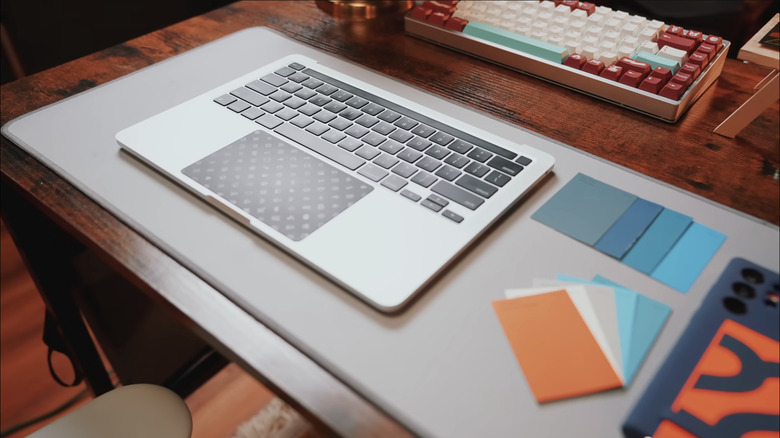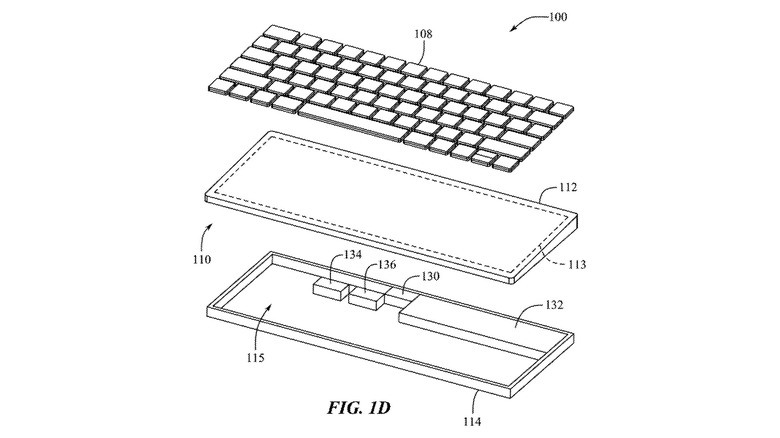Slabtops Explained: Why So Many People Are Buying Half Of A MacBook Pro
In early 2022, a strange new fad started to emerge online among MacBook users: Buying MacBooks without functioning displays or cannibalizing their own MacBooks themselves to completely remove the display. The goal? Turning the former notebook into a "Slabbook," a computer built into a keyboard/trackpad combo that they could use with a monitor or wirelessly with a TV over AirPlay. It might not be a coincidence that this picked up steam online in the weeks following the publication of an Apple patent application titled "Computer in an input device," which was decidedly similar to the "Slabbooks."
The keyboard housing containing the computer itself is not a new concept, as it was used by a few notable '80s computers, like the Commodore 64, the Sinclair ZX Spectrum, and even Apple's own Apple II. Aside from the early 2022 news about that patent application, though, why is this becoming a thing now? What exactly is the benefit of this compared to using a Mac desktop, particularly at a time when the addition of the Mac Studio and the refresh of the Mac Pro has made the Mac desktop lineup the most diverse it's been in years?
Let's face it: Laptops are uncomfortable
Laptops are a blessing and a curse. They allow you to work much more freely, particularly if you work at home. They don't require dedicating space to a desk, either, which is a big deal if you live somewhere like New York City where space is at a premium. However, they're not the most ergonomically sound devices. It takes a lot of relative gymnastics to use a laptop in a position that doesn't require tilting your head down toward it. Though there are simple life hacks that can help, like wearing a travel pillow with the closed side under your chin to support your head and neck, laptop use can wreak havoc on your neck.
"With repetition, that force can strain or injure the facet joints that connect our vertebrae," said Dr. Kavita Trivedi, Associate Medical Director of the Spine Center at UT Southwestern Medical Center, in a February 2023 interview on the university's website. "When that happens, the surrounding muscles naturally tighten up to protect nearby nerves, which leads to inflammation, pain, and knots in your neck — what is often referred to as tech neck."
Have we evolved past laptops?
A "Slabbook" — or something like it — could help solve this in many use cases. A traditional desktop keyboard and trackpad wouldn't necessarily be comfortable while working on a couch or in a recliner, but the keyboard half of a MacBook or other notebook shell is designed to be used that way. It feels comfortable. And on Macs in particular, where AirPlay makes it trivial to wirelessly use a TV as your monitor, it's a lot easier to envision why this would be desirable. What if you could just park yourself in front of the TV and use that as the display for the comfortable part of a laptop?
Suddenly, the appeal of a "Slabbook" clicks into place, as do other benefits that make the idea work. Newer, Apple Silicon-based MacBooks already have fantastic battery life, but imagine how much better that battery life would be without having to power a display? And if you don't want to operate on a perfectly good MacBook, recently sold eBay listings show that you could pick up an M1 MacBook with a cracked screen for a few hundred dollars.
Some caveats do apply, with the biggest one being that the recovery mode on MacBooks requires the built-in display. Plus you'll be getting rid of the webcam, and if you're planning on doing wireless screen mirroring, you have to hook the computer up to a monitor to configure the AirPlay settings. And if you're using a MacBook Pro from 2008 to 2010, the Wi-Fi antenna is in the display hinge, so you'd lose out on that.


